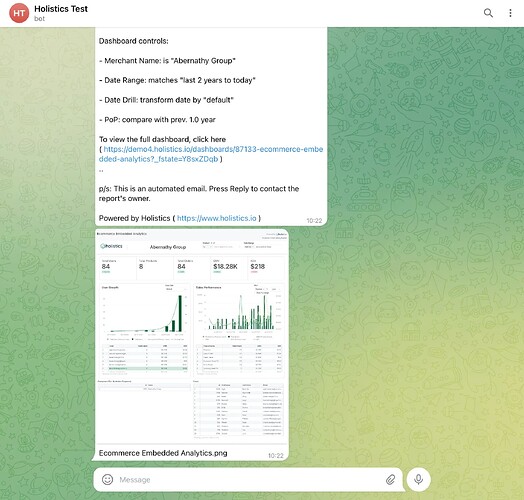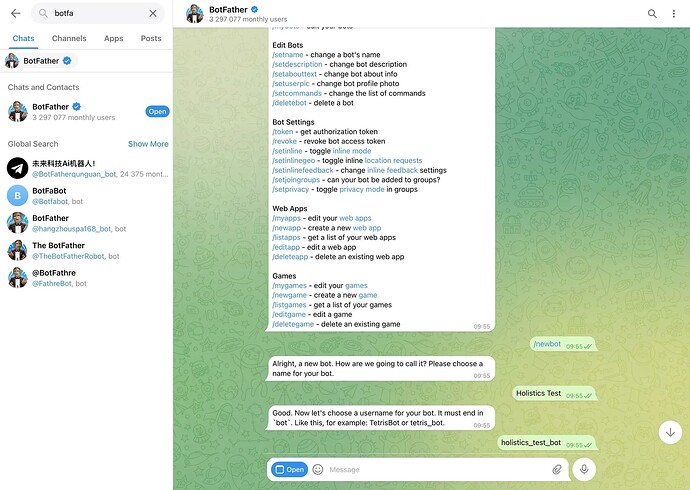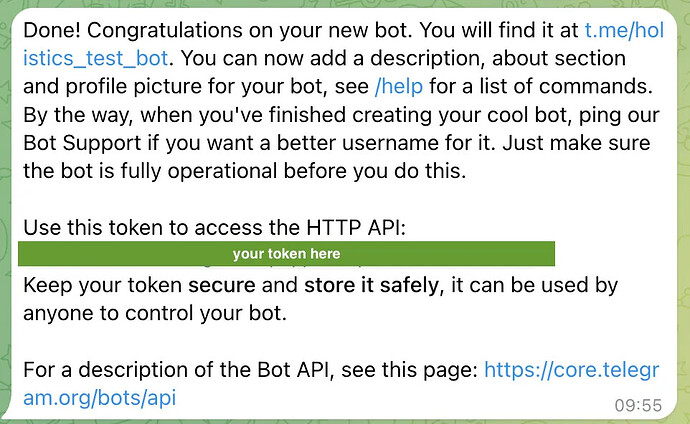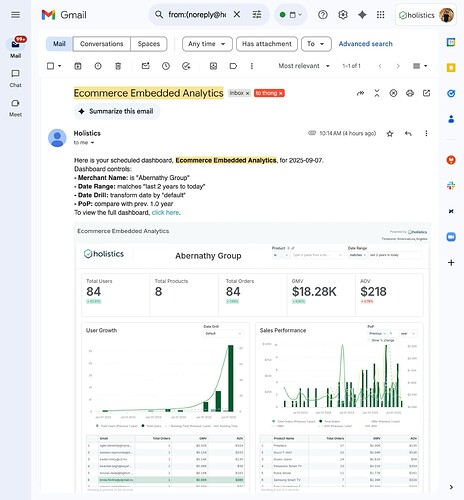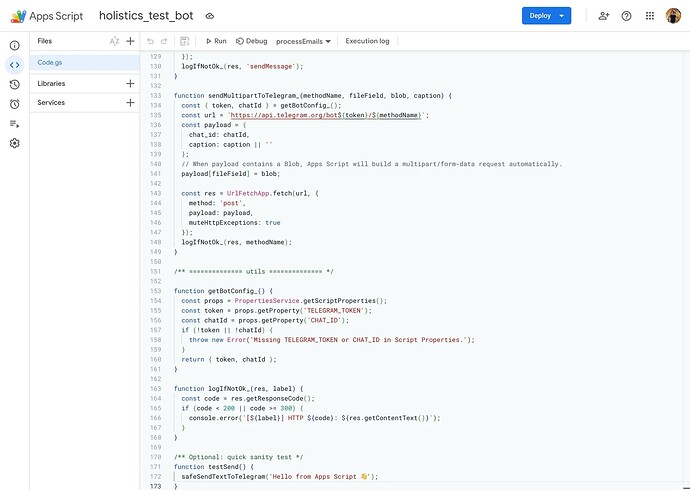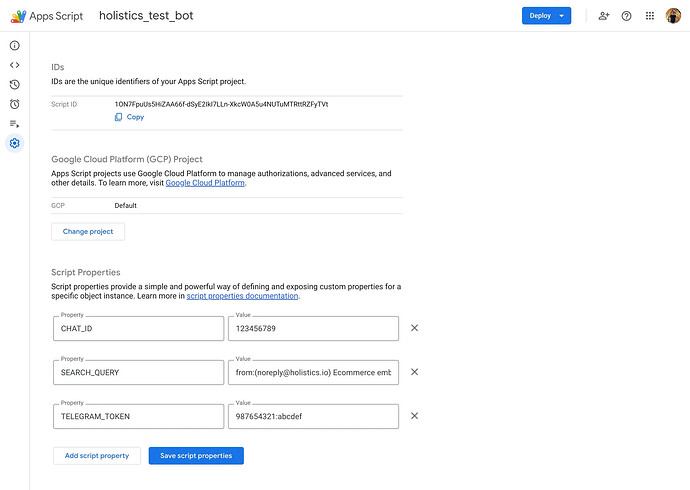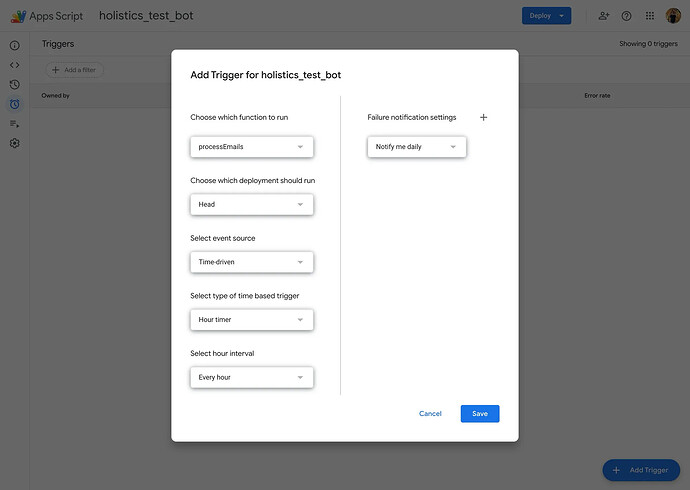Ever wish your Holistics dashboards just popped up in Telegram instead of your inbox? I just found out, with a quick script, you can forward scheduled dashboards straight into a Telegram channel, keeping your team updated instantly, no emails needed.
Benefits of Telegram schedules
- Real-time alerts: Dashboards (like daily sales dashboards, weekly performance summaries, etc.) are delivered instantly to Telegram, so teams don’t need to check email.
- Mobile-friendly: Executives get notifications directly on their phones.
- Collaborative: Teammates can reply, pin, or forward dashboards for discussion.
High-level Approach
This guide walks you through creating a simple automation that forwards Holistics email scheduled dashboards from Gmail directly to Telegram. The setup involves three main steps:
- Create a Telegram Bot - Generate a bot token and chat ID
- Set up Holistics email schedules - Have dashboards automatically delivered to your inbox.
- Automate Gmail to Telegram with Google Apps Script – Use a script to forward scheduled dashboards to your Telegram channel via the bot
Disclaimer: This guide uses Gmail and Google Apps Script. If you use Outlook, Exchange, or other providers, you can achieve similar results with IMAP scripts or automation tools (e.g., Microsoft Power Automate).
Step 1: Create a Telegram Bot to retrieve bot token and chat ID
1.1. Open Telegram and search for @BotFather. Use the command /newbot to create a bot.
1.2. Get the bot token shown after creation.
1.3. Find your chat ID:
-
If you want the bot to send messages directly to you
- Open the bot link (
t.me/your_bot_name), send a test message “Hello” to your new bot in Telegram. - Visit
https://api.telegram.org/bot<YOUR_TOKEN>/getUpdatesin a browser. - Look for the
chat.idfield in the JSON response.
- Open the bot link (
-
If you want the bot to send messages to a group
- Invite your bot to an existing channel (or create a new one) as admin
- Visit
https://api.telegram.org/bot<YOUR_TOKEN>/getUpdatesin a browser. - Look for the
chat.idfield in the JSON response. The ID of a group chat should be negative (e.g., -123456789).
Step 2: Create email schedules for your dashboards
Now, create email schedules for your Holistics dashboards. The dashboard will arrive in your inbox automatically. You can find step-by-step instructions in the: Holistics Docs – Schedule Report Delivery.
Tips: You can create a dedicated email account (e.g., [email protected]) that Holistics can forward scheduled emails to. This keeps your Telegram notifications separate and easier to manage.
Step 3: Create an automation in Google Apps Script
3.1 Create a new project
Go to Google Apps Script, create a new project and paste in the provided script below. The script will process Gmail messages and forward them to Telegram, including attachments.
/** ====== CONFIG via Script Properties ======
* TELEGRAM_TOKEN: bot token from @BotFather
* CHAT_ID: target chat/channel ID (number; negative for groups)
* SEARCH_QUERY: Gmail search query (e.g., 'label:to-telegram is:unread')
* INCLUDE_INLINE: 'true' to include inline images (cid), else 'false'
* SIZE_LIMIT_MB: max size to upload directly (default 49)
* SEND_IMAGES_AS_PHOTOS: 'true' to send images via sendPhoto; else sendDocument
* POST_PROCESS: 'mark_read' | 'archive' | (leave blank for no-op)
* PROCESSED_LABEL: label name to add after successful forward (optional)
* ===========================================
*/
function processEmails() {
const props = PropertiesService.getScriptProperties();
const query = props.getProperty('SEARCH_QUERY') || 'label:to-telegram is:unread';
const includeInline = (props.getProperty('INCLUDE_INLINE') || 'false') === 'true';
const sizeLimitBytes = ((Number(props.getProperty('SIZE_LIMIT_MB')) || 49) * 1024 * 1024);
const processedLabelName = props.getProperty('PROCESSED_LABEL') || '';
const postProcess = (props.getProperty('POST_PROCESS') || '').toLowerCase();
const threads = GmailApp.search(query, 0, 20); // adjust page size as you like
const processedLabel = processedLabelName ? GmailApp.createLabel(processedLabelName) : null;
threads.forEach(thread => {
const messages = thread.getMessages();
messages.forEach(msg => {
if (msg.isInTrash()) return;
// 1) Send email meta + body snippet
const subject = msg.getSubject() || '(no subject)';
const from = msg.getFrom() || '';
const date = msg.getDate();
const snippet = (msg.getPlainBody() || '').trim();
const excerpt = snippet.length > 3500 ? (snippet.slice(0, 3500) + '\n…') : snippet;
const header =
'📧 ' + subject + '\n' +
'From: ' + from + '\n' +
'Date: ' + (date ? date.toString() : '') + '\n\n';
safeSendTextToTelegram(header + excerpt);
// 2) Send attachments
const atts = msg.getAttachments({
includeInlineImages: includeInline,
includeAttachments: true
});
atts.forEach(att => {
try {
const blob = att.copyBlob();
const name = att.getName() || 'file';
blob.setName(name);
// size guard
const bytes = blob.getBytes(); // Apps Script returns byte[]
const len = bytes ? bytes.length : 0;
if (len === 0) return;
if (len <= sizeLimitBytes) {
const isImage = (blob.getContentType() || '').startsWith('image/');
const sendAsPhoto = (props.getProperty('SEND_IMAGES_AS_PHOTOS') || 'true') === 'true';
if (isImage && sendAsPhoto) {
safeSendPhotoToTelegram(blob, name);
} else {
safeSendDocumentToTelegram(blob, name);
}
} else {
safeSendTextToTelegram('⚠️ Attachment too large to send directly: ' +
`${name} (~${Math.round(len / 1048576)} MB)`);
}
Utilities.sleep(400); // pacing to be gentle on rate limits
} catch (e) {
safeSendTextToTelegram('⚠️ Error sending attachment: ' + (att.getName() || 'file') +
'\n' + (e && e.message ? e.message : e));
}
});
// 3) Post-process
if (postProcess === 'mark_read') msg.markRead();
if (postProcess === 'archive') thread.moveToArchive();
if (processedLabel) thread.addLabel(processedLabel);
});
});
}
/** ============== Telegram helpers ============== */
function safeSendTextToTelegram(text) {
try {
sendTextToTelegram(text);
} catch (e) {
console.error('sendMessage error:', e);
}
}
function safeSendDocumentToTelegram(blob, caption) {
try {
sendMultipartToTelegram_('sendDocument', 'document', blob, caption);
} catch (e) {
console.error('sendDocument error:', e);
safeSendTextToTelegram('⚠️ Failed to send document: ' + (blob && blob.getName ? blob.getName() : 'file'));
}
}
function safeSendPhotoToTelegram(blob, caption) {
try {
sendMultipartToTelegram_('sendPhoto', 'photo', blob, caption);
} catch (e) {
console.error('sendPhoto error:', e);
safeSendTextToTelegram('⚠️ Failed to send photo: ' + (blob && blob.getName ? blob.getName() : 'image'));
}
}
function sendTextToTelegram(text) {
const { token, chatId } = getBotConfig_();
const url = `https://api.telegram.org/bot${token}/sendMessage`;
const payload = {
chat_id: chatId,
text: text,
disable_web_page_preview: true
// You can also add parse_mode: 'HTML' and escape content if you prefer
};
const res = UrlFetchApp.fetch(url, {
method: 'post',
contentType: 'application/json',
payload: JSON.stringify(payload),
muteHttpExceptions: true
});
logIfNotOk_(res, 'sendMessage');
}
function sendMultipartToTelegram_(methodName, fileField, blob, caption) {
const { token, chatId } = getBotConfig_();
const url = `https://api.telegram.org/bot${token}/${methodName}`;
const payload = {
chat_id: chatId,
caption: caption || ''
};
// When payload contains a Blob, Apps Script will build a multipart/form-data request automatically.
payload[fileField] = blob;
const res = UrlFetchApp.fetch(url, {
method: 'post',
payload: payload,
muteHttpExceptions: true
});
logIfNotOk_(res, methodName);
}
/** ============== utils ============== */
function getBotConfig_() {
const props = PropertiesService.getScriptProperties();
const token = props.getProperty('TELEGRAM_TOKEN');
const chatId = props.getProperty('CHAT_ID');
if (!token || !chatId) {
throw new Error('Missing TELEGRAM_TOKEN or CHAT_ID in Script Properties.');
}
return { token, chatId };
}
function logIfNotOk_(res, label) {
const code = res.getResponseCode();
if (code < 200 || code >= 300) {
console.error(`[${label}] HTTP ${code}: ${res.getContentText()}`);
}
}
/** Optional: quick sanity test */
function testSend() {
safeSendTextToTelegram('Hello from Apps Script 👋');
}
3.2 Configure script properties
Use Script Properties for configuration. In Apps Script → click Project Settings → Script properties → Open editor. Add the following key–value pairs:
| Property Key | Example Value | Notes |
|---|---|---|
TELEGRAM_TOKEN |
123456789:ABCdefGhIjKlMnOpQrStUvWxYz |
* Required (From Step 1) |
CHAT_ID |
1001234567890 |
* Required (From Step 1) |
SEARCH_QUERY |
from:[email protected] subject:Sales Dashboard |
Gmail search query targeting Holistics schedules |
SIZE_LIMIT_MB |
49 |
Telegram limit ~50MB |
INCLUDE_INLINE |
false |
Whether to forward inline images. |
SEND_IMAGES_AS_PHOTOS |
true |
Sends images via sendPhoto |
POST_PROCESS |
mark_read |
Options: mark_read, archive, or leave blank |
3.3 Add Triggers
In Apps Script, go to Triggers (clock icon). Add trigger:
- Function:
processEmails - Event source: Time-driven
- Select every hour (or desired frequency).
Now, the script will check Gmail periodically and forward any matching emails to Telegram.
4. Result
From now on, the script runs on schedule. Gmail will be checked automatically every few minutes (or at the interval you set, such as hourly), and whenever Holistics delivers a dashboard to your inbox, it will be forwarded straight to your Telegram channel.
Best practices
Duplicates: To avoid re-sending the same Holistics schedule multiple times, configure Gmail queries carefully (e.g., is:unread) and use post-processing options such as marking messages as read or applying a processed label. Without these safeguards, the script may forward duplicate emails.
